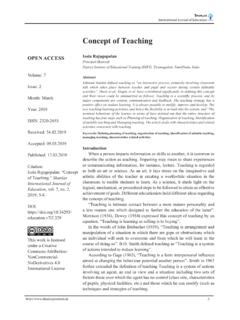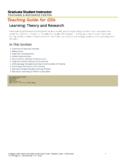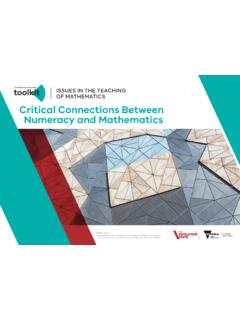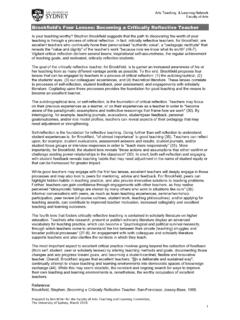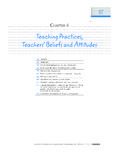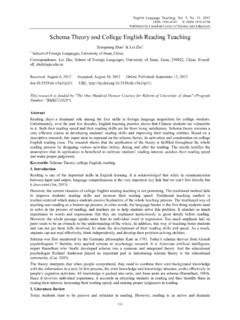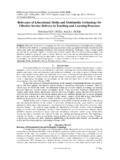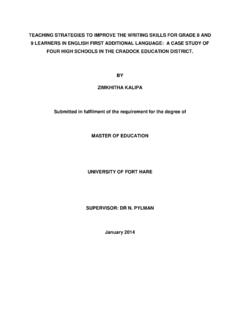Transcription of Teaching Strategies in Nursing
1 Best Practices in Teaching StrategiesEAST TENNESSEE STATE UNIVERSITYPATSY MILLER-PAMPKIN, PHD, MSN, RNAPRIL 11, 2016 Objectives After this presentation, the audience will be able Core Competencies for Nurse characteristics of today s student the value of educational philosophies and learning evidence-based Teaching Strategies NLN s Excellence in Nursing Education ModelThe NLN Excellence in Nursing Education Model comprises eight core elements: A well-prepared faculty Student-centered, interactive, and innovative programs and curricula Evidence-based programs and Teaching /evaluation methods Qualified students Clear program standards and hallmarks that raise expectations Means to recognize expertise Quality and adequate resources Well-prepared educational administratorsNLN, 2006 Excellence in Nursing EducationNLN, 2006 NLN, 2006 NLN, 2006 NLN, 2006 NLN, 2006 NLN, 2006 NLN, 2006 NLN, 2006 NLN, 2006 NLN Nurse Educator Core Competencies Competency I: Facilitate Learning Nurse educators are responsible for creating an environment in classroom, laboratory, and clinical settings that facilitates student learning and the achievement of desired cognitive, affective, and psychomotor outcomes.
2 Competency II: Facilitate Learner Development and Socialization Nurse educators recognize their responsibility for helping students develop as nurses and integrate the values and behaviors expected of those who fulfill that role. Competency III: Use Assessment and Evaluation StrategiesNurse educators use a variety of Strategies to asses and evaluate student learning in classroom, laboratory and clinical settings, as well as in all domains of learning. NLN, 2013 NLN Nurse Educator Core Competencies Competency IV: Participate in Curriculum Design and Evaluation of Program Outcomes Nurse educators are responsible for formulating program outcomes and designing curricula that reflect contemporary health care trends and prepare graduates to function effectively in the health care environment. Competency V: Function as a Change Agent and Leader Nurse educators function as change agents and leaders to create a preferred future for Nursing education and Nursing practice.
3 Competency VI: Pursue Continuous Quality Improvements in the Nurse Educator Role Nurse educators recognize that their role is multidimensional and that an ongoing commitment to develop and maintain competence in the role is , 2013 NLN Nurse Educator Core Competencies Competency VII: Engage in Scholarship Nurse educators acknowledge that scholarship is an integral component of the faculty role, and that Teaching itself is a scholarly activity. Competency VIII: Function Within the Educational Environment Nurse educators are knowledgeable about the educational environment within which they practice and recognize how political, institutional, social, and economic forces impact their role. NLN, 2013 Nursing Education in the Classroom Setting Characteristics of today s student learners Of all ages; From many different lifestyles, ethnic, and cultural backgrounds; With different generational characteristics; And, most importantly, with different learning styles.
4 (Whittmann-Price, 2013)Educational Philosophies Positive Environment- must be established for learning to take place. Environment must be built on philosophical foundations that: Are never stagnant and change as the larger social system matures Provide the foundations on which learning theories and educational pedagogies are built Consider the branch of philosophy that addresses why we teach, how we teach, and what the goals of education are for learners and society Date back to Florence Nightingale, who can be credited with the first Nursing education philosophy(Whittmann-Price, 2013)Educational PhilosophiesTraditional Teaching Philosophies Teacher-centered Based on what the educator could provide to the learnerPostmodern Philosophies Take into account social meaning of learning and the relationship between knowledge and power Consider multiple and innovative ways of learning(Whittmann-Price, 2013)
5 Learning TheoriesTeaching What the educator provides the learner in terms of goals, methods, objectives, and outcomes. Learning The processes by which the learner changes skills, knowledge, and dispositions through a planned , (2013)Learning Theories Theoretical Frameworks Formalize how people learn and how they store, connect, discover, and retrieve skills and information Try to explain the connection between knowledge and the human , (2013 Learning Theories Educational Philosophy Guide Learning Theories Philosophies are driven by Metaphysics (the study of what s real) Epistemology (study of what is truth and knowledge) Axiology (study of what is good) Learning Theories More defined concepts More applicable to Teaching situations than are philosophies(Whittmann-Price, 2013)Evidence-Based Teaching Practice Rossetti and Fox (2009))
6 Studied interpretive statements of educators, recognized for excellence, from various disciplines and identified four themes in their written educational philosophies: Presence, Promotion of learning, Educators as learners, and Enthusiasm.(Whittmann-Price, 2013)Models Specific to Nursing Carper (1978) described four ways that nurses understand practice situations: 1. Empirical or scientific knowledge (includes evidence-based practice [EBP])2. Personal knowledge or understanding how you would feel in the patient s position 3. Ethical knowledge or attitudes and understanding of moral decisions 4. Aesthetic knowledge or understanding the situation of the patient at the moment Munhall (1993) added the fifth way of knowing: Unknowing or understanding that the nurse cannot know everything about the patient and must place him- or herself in a position willing(Whittmann-Price, 2013)Models Specific to Nursing Benner (1982) described five levels of Nursing expertise.
7 A beginner with no experience beginner a person who is at the point of demonstrating acceptable performance typically a nurse with 2 to 3 years experience in the same role a nurse who perceives and understands situations as a whole a nurse who no longer relies on principles, rules, or guidelines to understand patient needs and determine actions(Whittmann-Price, 2013)Deep, Surface, and Strategic Learning Deep learning approach A learner addresses material with the intent to understand both the concepts and meaning of the information. Surface learning, or atomistic, approach Memorization of facts and details. Motivation for surface learning, which is primarily extrinsic, is driven by either the learner s fear of failing or the desire to complete the course successfully. Strategic learning approach The learner does what is needed to complete a course.
8 S Strategic learning is a mixture of both deep and surface learning techniquesWhittmann-Price, 2013)Motivational Theories Extrinsic motivation Based on external variables such as grades or earning money. Intrinsic motivation Has to do with the feeling of accomplishment, of learning for the sake of learning, or the feeling that being a nurse is something the learner always wanted to do. Typically, intrinsic motivation is associated with better retention Intrinsic motivation is correlated with Self-Determination Theory According to the theory, humans have three types of needs: To feel competent; To feel related ; and To feel autonomousWhittmann-Price, 2013 Motivational Theories ARCS Model Keller (1987) talks about the factors that educators can implement to motivate learners in the ARCS model: A Attention (keeping the learner s attention through stimulus changes in the classroom or clinical setting) R Relevance (make the information relevant to the learner s goals) C Confidence (make expectations clear so the learner will engage in learning) S Satisfaction (have appropriate consequences for the learner s new skills)Whittmann-Price, 2013 Motivational Theories Brophy Model (1986) listed the following methods by which motivation is formed.
9 Modeling Communication of expectations Direct instruction Socialization by parents and educatorsWhittmann-Price, 2013 Motivational Theories Vroom s Expectancy Model Vroom s expectancy model (VEM) Describes what people want and whether they are positioned to obtain it. Three concepts: Force (F) The amount of effort a person will put into reaching a goal Valence (V) How attractive the goal is to the person Expectancy (E) The possibility of the goal being achieved The VEM model is F = V E (Vroom, 1964).Whittmann-Price, 2013 Motivational Theories DeYoung lists 10 principles to motivate learners: several senses involve the if the learner thinks the information is learning with what is information at an appropriate a learning-friendly environmentWhittmann-Price, 2013 Teaching Styles and EffectivenessAndragogyPedagogyDefinition The methods and practices used in Teaching methods and practices used in Teaching , especially of independent, self-directed, and/or cooperative learning among a teacher's methods of transferring knowledge to a student, who is dependent on the teacher's methods and have control over much of their learning experience and must be motivated to learn.
10 Can often seek out new or different learning experience, at controls the learning experience for children, and much of what is taught is based on rigid of GradesMay be very lowHighTeaching Styles and EffectivenessQuirk s Classification of Teaching Styles Assertive An assertive style is usually content-specific and drives home information. Suggestive Educator uses experiences to describe a concept and then requests the learners research more information on the subject. Collaborative The educator uses skills to promote problem solving and a higher level of thinking in the learners. Facilitative Educators using this style often challenge the learners to reflect and use affective learning. Educators challenge learners to ask ethical questions and to demonstrate skill with interpersonal relationships and professional , 2013 Teaching Styles and Effectiveness Kelly s Teaching Effectiveness Kelly (2008) studied learners perceptions of Teaching effectiveness and found that the most important three attributes were: Teacher knowledge Feedback Communication skillsWhittmann-Price, 2013 Teaching Styles and Effectiveness House, Chassie, and Spohn sTeaching Behaviors (1999) provide examples of the following behaviors and their effect on learners: Making eye contact can encourage learner participation in class.










